Composite Bonding. Head-turners.
Transform your smile here.


A simple smile enhancement.
Composite bonding is a popular, cost-effective dental treatment that can dramatically enhance the appearance of your teeth in just a single visit.
This procedure involves applying a tooth-colored resin material to your teeth, which is then shaped and hardened with a special light. It’s an ideal solution for minor cosmetic dental issues. This treatment can also be used to make teeth look longer or to change their shape, creating a more pleasing appearance.
Composite Bonding.
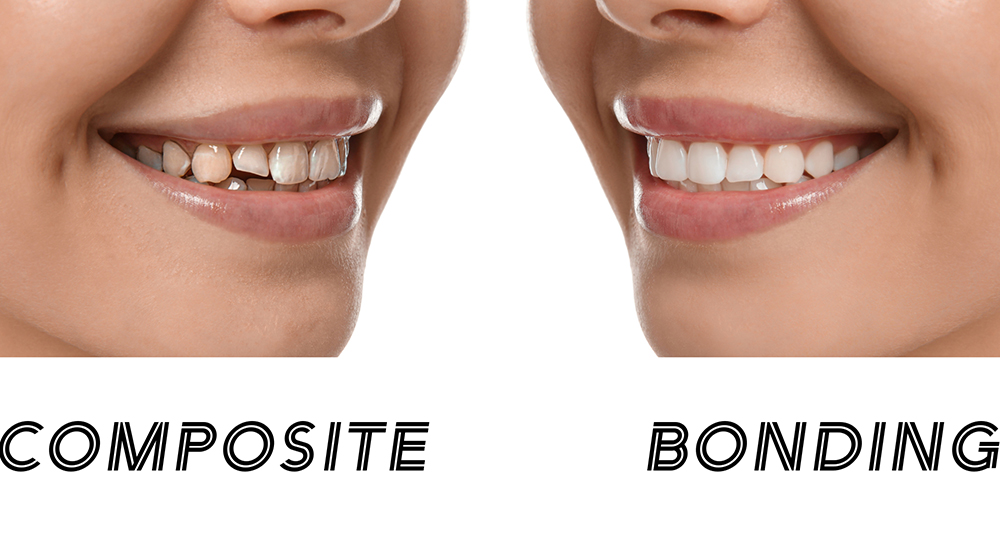
Today, your smile makes a big difference in your personal and professional life. Composite bonding, one of the innovative methods offered by aesthetic dentistry, offers a minimally invasive approach to reveal the natural beauty of your teeth. With the direct application of tooth-colored resin material, minor imperfections, gaps and slight discolorations are effortlessly removed while preserving your tooth tissue. With this method, you can quickly and affordably get the beautiful smile you have always wanted.
The composite bonding procedure is a cosmetic dental treatment that involves applying a tooth-colored resin material to the surface of the teeth. Here is the composite bonding procedure step by step:
Direct Composite Veneer Technique:
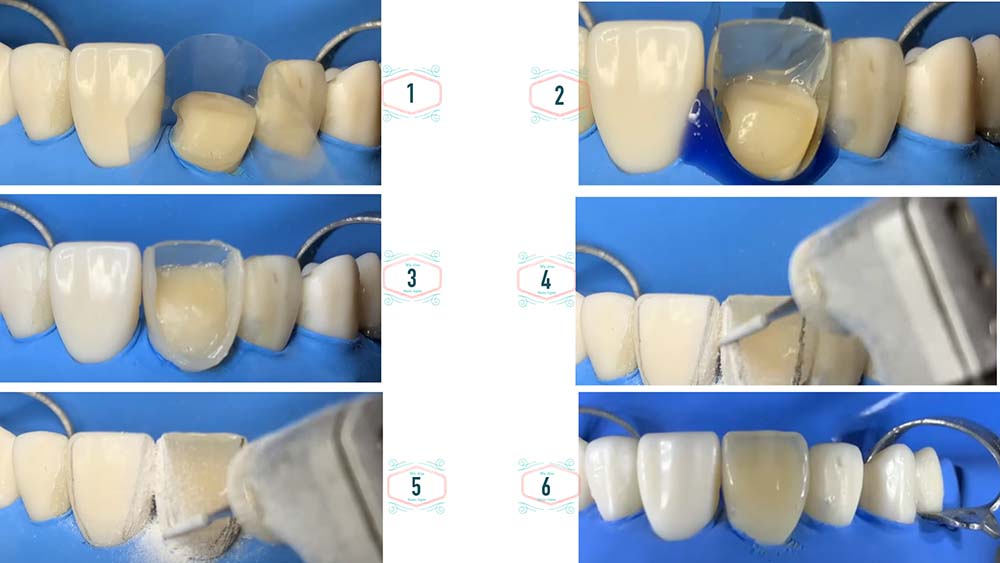
- Examination and Color Selection: First, the dentist assesses the patient's oral health and determines if they are suitable for composite bonding. The color of the teeth is determined and a resin is selected to match this color.
- Isolation: The teeth are isolated with a retractor or a rubber sheet that pushes the cheeks away. This ensures good adhesion of the resin to the tooth.
- Cleaning the teeth: After bonding, the surfaces of the teeth are cleaned. This helps to make bonding more effective. In this technique, there is usually minimal or no preparation of the tooth surface. The aprismatic upper surface of the tooth is sometimes removed to provide a better bond.
- Dental Adhesive Application: A dental adhesive is applied to the tooth surface to ensure that the resin adheres to the tooth.
- Composite Application: The dentist applies the composite material to the tooth by freehand shaping. This process may involve changing the shape, length or color of the teeth. The composite material has the consistency of paste. The dentist tries to achieve an aesthetic appearance by using composites in different colors and brands. The selected composites are applied to the tooth surface in layers. Each layer is shaped into the appropriate anatomical form. No bonding agent is used at this stage.
- Shaping: The composite is slowly shaped into the tooth using different instruments. This stage is a process in which the dentist uses his or her artistic skills. A slight excess is left when shaping the composite into the desired shape.
- Curing: After forming is complete, the composite is cured with a special UV light. This light causes the composite to change from soft to hard.
- Polishing: Finally, the composite surface is polished. This makes the teeth look smooth and natural.
- Final Checks: At the end of the procedure, checks are performed to make sure the patient is comfortable and happy.
Indirect Composite Veneer Technique:
This technique combines the advantages of the direct method with the precision of the indirect method.
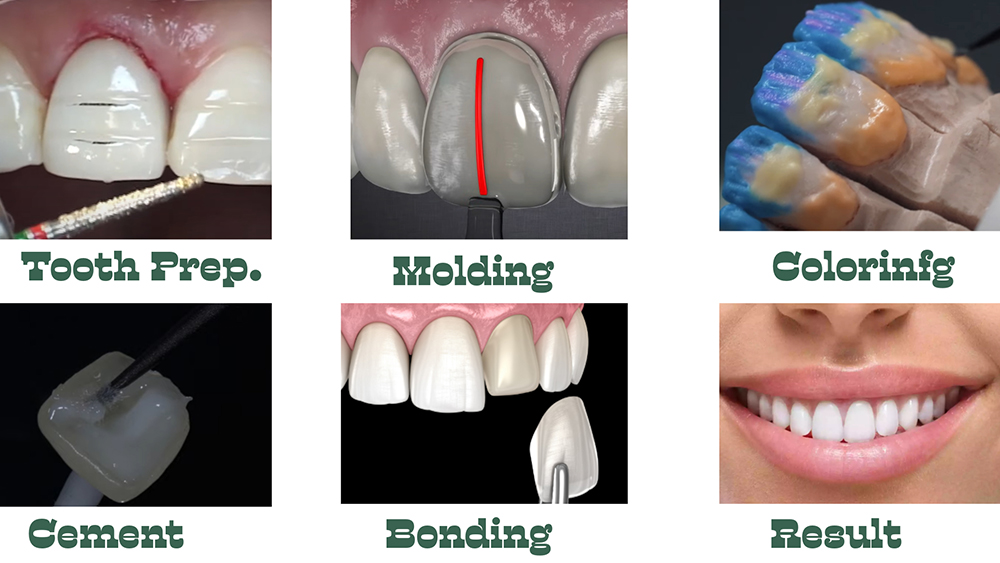
- Tooth Preparation:
- The tooth is properly prepared for the veneer. This may be in the enamel or sometimes in the enamel and dentin.
- Preparation involves the loss of a certain amount of material from the tooth.
- The enamel surface may need to be removed by about 0.5 mm.
- Forming First Impression:
- The prepared tooth is measured and sent to the laboratory.
- Fabricating Veneers:
- In the laboratory, composite veneers are prepared according to the size. This process is performed using special techniques and materials.
- Indirect techniques are preferred in more complex cases and offer better aesthetic results.
- Highly filled hybrid composites, developed in recent years, offer physicochemical and mechanical properties.
- Veneer Proofing and Color Selection:
- The prepared veneer is rehearsed on the tooth before bonding, its fit and color are checked.
- Bonding (Luting):
- The tooth surface and the inner surface of the veneer are properly prepared. This may include pickling, silane application and the use of a bonding agent.
- The veneer is bonded to the tooth with a light-curing or dual-curing composite adhesive.
- Excess adhesive material is removed.
- Finishing and Polishing:
- After gluing, the veneer takes its final shape and is polished.
Bonding Phase:
- Etching: The inner surface of the porcelain veneers is acidified with hydrofluoric acid to create microporosities.
- Silane Application: The pickled porcelain surface is coated with silane, which strengthens the chemical bond between the composite and porcelain.
- Bonding Agent: Bonding agent is applied to both the tooth and the inner surface of the veneer, increasing the bond strength.
- Bonding Composite: Light-cure or dual-cure composites are used to bond veneers to the tooth. Light-cured composites offer a longer working time, but care must be taken with the light transmittance of the porcelain.
- Heat Treatment: Heating silane-coated porcelain doubles the bond strength.
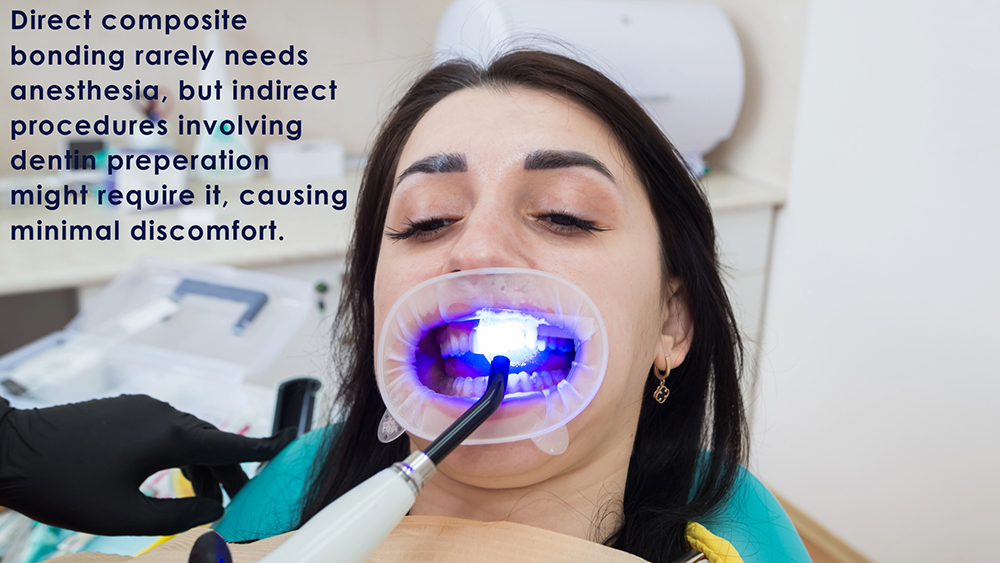
The pain or need for anesthesia during the composite bonding process depends entirely on the technique applied, the condition of your tooth and your sensitivity. For example, in the direct composite veneer technique, there is almost no preparation on your tooth; only the upper surface of the tooth is slightly roughened and cleaned. Therefore, since there is no intervention close to the nerves, you usually do not feel pain and anesthesia is not needed.
On the other hand, in some cases, indirect methods are used and a light preparation can be done on your tooth. If the tooth enamel layer is completely protected during this preparation, no anesthesia is needed, but if your tooth is sensitive, you may feel some discomfort. If the dentin layer is penetrated during the procedure, especially near the gingival margin, this may cause some sensitivity in your tooth and in such cases, anesthesia may be applied for your comfort.
For aesthetic or phonetic reasons, people sometimes prefer temporary restorations. The placement or removal of these restorations may also cause minor discomfort, but anesthesia is usually not required. Your dentist will try to minimize this sensitivity by coating your tooth surface with special protective materials to prevent sensitivity that may occur after the procedure.

Composite bonding can be a great option to solve aesthetic and minor restorative problems with your teeth. Of course, it may not be suitable for everyone, so let's summarize in which cases composite bonding will work and in which cases you should consider different solutions:
- Aesthetic Problems: If you have aesthetic problems such as discrepancies in your tooth color, slight irregularities in your tooth shape or diastemas (gaps between teeth), composite bonding is ideal for solving these problems. It can make precise adjustments in terms of color and form to restore your teeth to their natural appearance.
- Minimal Intervention: If you want to preserve your tooth structure, direct techniques are performed with almost no intervention to your teeth. In other words, an aesthetic change is achieved without damaging the natural tissue of the tooth.
- Those who want to get fast results: This procedure, which can be completed in a single session, is a great advantage for those who want to see results quickly. If your time is limited, you can get the look you want in a short time thanks to this method.
- Those Looking for a Budget-Friendly Solution: Composite veneers offer a more economical option than ceramic veneers. So if you are looking for an aesthetic and budget-friendly solution, composite bonding may be ideal.
- Easy Repair: In case of any minor problem, the composite material can be easily repaired. If there are problems such as fractures or edge leakage, the intervention is quite simple.
- Those With Controlled Problems Such As Bruxism: If you have habits such as teeth grinding, this may affect the durability of composite bonding. However, for mild and controlled parafunctions, state-of-the-art composites can be durable enough.
- Those with Sufficient Enamel: Having most of your tooth covered with enamel increases the success of composite bonding because the enamel allows the composite material to adhere better to the tooth.
- Those with High Aesthetic Expectations: Composite veneers can almost exactly mimic the natural color and texture of your teeth, especially when applied with indirect techniques. If you are looking for aesthetically perfect results, this method is for you.
On the other hand, composite bonding may not be suitable in some cases:
- If your teeth are severely discolored, composite veneers alone may not be sufficient and more opaque materials or alternative treatments may be required.
- Serious Tooth Position Problems: If your teeth are severely crowded or out of position, orthodontic treatment may be necessary first. In such cases, composite bonding alone may not offer a solution.
- Uncontrollable Habits such as Bruxism: If you have habits such as teeth grinding and cannot control them, the lifespan of composite veneers may be shortened. In such cases, it is important to treat or manage the habit first.
In conclusion, composite bonding offers a fast, aesthetic and affordable treatment method, but it is always best to have a detailed assessment with your dentist to make the best decision. Your dentist will determine the most appropriate treatment plan, taking into account your specific situation.
Composite bonding treatment is a minimally invasive method to improve the appearance of your teeth. It has both advantages and some disadvantages. Let's take a frank look at what this treatment has to offer:
Advantages:
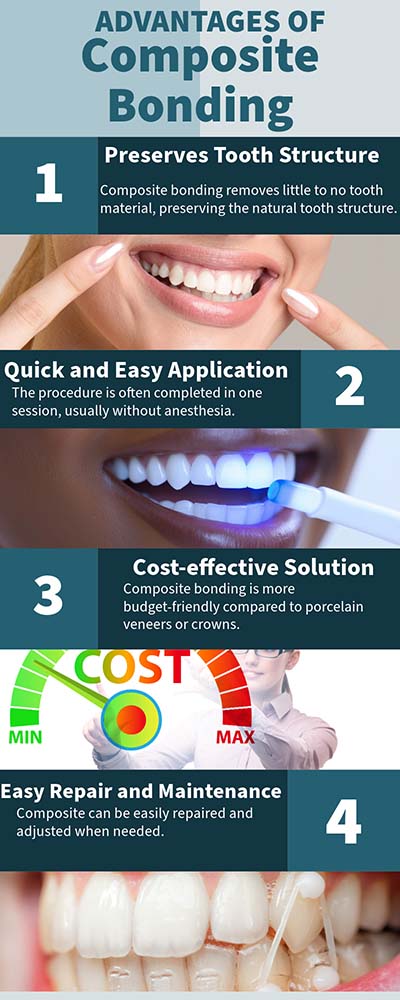
- Don’t damage your teeth: Composite bonding works almost without damaging your tooth, especially in direct applications. The natural tissue of the tooth is preserved; that is, not too much or no material is removed. Thus, you preserve your tooth structure as much as possible.
- Fast and Easy Application: Especially with direct techniques, the procedure can usually be completed in one session. If you want to get results quickly, this method is ideal for you. Usually, anesthesia is not even needed during the procedure, making it very comfortable.
- An Affordable Solution: Compared to other cosmetic treatments such as porcelain veneers or crowns, composite bonding is much more budget-friendly. Thanks to its affordable cost, it offers an attractive option for those who want to make small touches to their dental aesthetics.
- Beautiful Aesthetic Results: Composite materials are very good at mimicking natural tooth color and texture. They are an effective way to correct discoloration, minor deformities or diastemas (gaps between teeth). As a result, you can achieve a more harmonious and aesthetic smile.
- Easy Repair Possibility: In case of any minor damage, composite material can be repaired more easily than other materials such as porcelain. For example, if a small fracture or edge leakage occurs, it is simpler to redo the procedure or have it repaired.
- Reducing Tooth Sensitivity: Since the procedure is performed without damaging your teeth, the risk of sensitivity can be minimized. If dentin is exposed during the preparation, your dentist will try to reduce sensitivity with protective primers or bonding agents.
Disadvantages:

- Durability Issues: Composite bonding materials can be less durable than porcelain or some other restorative options. The material can wear, stain or chip over time, especially if you have habits such as teeth grinding (bruxism).
- Risk of Discoloration: Over time, composite materials can become discolored or stained due to the effects of colorants such as tea, coffee and red wine. Therefore, good oral hygiene and regular teeth cleaning after the procedure are of great importance.
- Technical Precision: The success of the procedure depends on the experience of your dentist. Correct color matching, anatomical shape and proper preparation of the surface should be done with care to achieve the best result. Therefore, it is essential to have the application done by a well-trained specialist.
- Marginal Leakage Risk: The shrinkage and thermal expansion differences that can occur during the polymerization process of the composite material can lead to small gaps between the tooth and the material. This can cause gum problems or sensitivity in the long term, but with today's technology, these risks can be greatly reduced.
- Surface Roughness and Long-Term Success: In some cases, the surface of composite veneers can be rougher than porcelain. This can trigger plaque buildup and gingival inflammation. In addition, in the long term, problems such as color matching, wear and breakage can occur. Therefore, regular check-ups and good oral care are essential.
In summary, composite bonding treatment offers a minimally invasive, fast and affordable option for aesthetic and minor restorative corrections to your teeth. However, issues such as material durability, color stability and application sensitivity should also be taken into consideration. For the best result and a long-lasting restoration, it is always the best choice to work with an experienced dentist who evaluates your situation well.
Although composite bonding applications are not considered permanent, they can provide aesthetic and functional results for a very long time under the right conditions. In general, the lifespan of composite veneers varies between 5 and 10 years, but this period may vary depending on the materials used, the application technique, the enamel structure of the tooth, the patient's oral hygiene and even habits. For example, if the enamel layer of the tooth is preserved, the adhesion of the composite material to the tooth is better, which prolongs the life of the application. Likewise, the quality of the luting material and the technique of application also play an important role in the durability of the restoration.
Unfortunately, since composite materials are not as durable as ceramic or porcelain, problems such as wear, discoloration, fracture and even marginal leakage can occur over time. Especially habits such as teeth grinding (bruxism) can accelerate such problems. In addition, the surface of composite veneers can sometimes not be as smooth as porcelain, which can lead to plaque buildup and gum problems. However, good oral hygiene, regular polishing and periodic dental check-ups greatly reduce these risks.
Another advantage is that composite bonding is relatively easy to repair. In the event of minor damage, repairing the material can be simpler and more practical than with porcelain restorations. Nevertheless, the repairs may not be as perfect as the initial placement. Therefore, the durability of indirect composite veneers can be slightly improved by using heat-treated materials.
Composite bonding is a frequently preferred method to solve aesthetic problems on your front teeth, but it is useful to know that it is not a permanent solution. Generally, this application lasts for an average of 5 years; in some cases, it is also heard that it can last up to 10 or even 15 years. Of course, this period may vary depending on your personal habits, the quality of the material used and the application technique of your dentist.
Composite bonding on the front teeth can provide aesthetic and functional results for many years with good oral hygiene, regular maintenance and correct techniques. However, keep in mind that composite materials are subject to wear, staining and minor damage over time. For example, if you frequently consume coloring drinks such as tea, coffee or red wine, or if you have habits such as teeth grinding, the life of the bonding may be shortened. Therefore, regular dental cleanings and periodic visits to your dentist will contribute greatly to making this treatment last longer.
Below you can examine the prices of composite bonding in different countries.
| Country | Approximate Cost (USD per tooth) |
|---|---|
| United States | $300 - $600 |
| United Kingdom | $250 - $500 |
| Canada | $300 - $600 |
| Australia | $300 - $600 |
| Germany | $200 - $400 |
| Turkey | $150 - $300 |
| India | $100 - $250 |
Composite bonding is a frequently preferred method to improve dental aesthetics, but unfortunately, it is inherently prone to staining over time. This material is made up of small balls, and this structure can cause abrasion, discoloration and staining over the years. Composite bonding can fade and yellow over time, especially if you frequently consume coloring foods and beverages such as tea, coffee, red wine or if you smoke. In addition, plaque and tartar build-up can accelerate staining if not taken care of properly.
Fortunately, with the right care and some precautions, this can be avoided. First of all, it is very important to avoid colorants for the first 48 hours after bonding; avoiding drinks and foods such as tea, coffee and red wine during this period will help the material to stabilize. Afterwards, it is a good idea to limit the consumption of such products. Paying extra attention to your daily oral hygiene; brushing your teeth at least twice a day, flossing and regular dental check-ups will keep your bonding clean and shiny. Professional cleanings and regular polishing are also effective in removing surface stains.
Also, avoiding abrasive toothpastes or hard-bristled toothbrushes will prevent damage to your bonding surface. As a result, composite bonding applications can stain more easily than natural teeth, but with a good care routine and conscious consumption habits, you can avoid this problem and maintain its aesthetic appearance for a long time.
Properly caring for composite bonded teeth not only prolongs the life of your restoration but also preserves its aesthetic appearance. Here are the things you should pay attention to:
- Daily Oral Hygiene:
- Brush your teeth with fluoride toothpaste at least twice a day, preferably after meals.
- Use dental floss or an interdental brush to remove plaque and food debris from between your teeth.
- If you use mouthwash, choose products that do not contain alcohol.
- Avoid Coloring Substances:
- Avoid tea, coffee, red wine, cola and similar coloring foods and beverages in the first 48 hours after bonding.
- If you have to consume such substances, do not forget to rinse your mouth with water afterwards.
- Avoid Smoking and Harmful Habits:
- Smoking causes staining and yellowing of the bonding, so avoid smoking if possible.
- Avoid habits such as using your teeth like a tool (opening packages, biting hard objects).
- Regular Professional Care:
- Visit your dentist for a professional cleaning every 6 months. This cleaning helps to remove stains and plaque from the surface of the bonding.
- If necessary, your dentist will maintain the brightness of your teeth by performing special polishing procedures.
- Choose the Right Products:
- Avoid abrasive toothpastes and hard-bristled toothbrushes; use products recommended by your dentist for sensitive teeth.
- If you have habits such as bruxism (teeth grinding), consider using a night guard.
- Regular Checkups:
- Have your dentist check the condition of your bonding regularly. Early intervention prevents any wear, staining or damage from escalating.
By following these simple but effective care rules, you can maintain the aesthetic and functional properties of your composite bonding for many years to come. Remember, regular care and good communication with your dentist is the foundation of your dental health!
Yes, composite bonding is an effective method for closing gaps between teeth. Your dentist applies a tooth-colored and custom-shaped composite material directly onto the teeth to fill the space, resulting in a natural and aesthetic appearance. This method preserves the natural look with minimal intervention to your tooth structure and is generally suitable for small to medium-sized diastemas. If the gap is too wide, alternative treatment options may be considered. In general, with proper application and regular care, composite bonding can quickly and effectively enhance your smile.
Composite bonding is a popular procedure to improve the appearance of your teeth; however, it’s important to be aware that it can potentially lead to some unwanted issues in the long term. For example, when bonding needs to be redone, a slight surface abrasion on the tooth may become necessary. Over time, this can lead to thinning of the enamel and weakening of the tooth, possibly resulting in a need for more extensive restorative procedures, even root canal treatment in some cases.
Additionally, due to the nature of the composite material, it is prone to wear and staining over time. If you frequently consume colored beverages such as tea, coffee, or red wine, or if you smoke, the bonding may discolor—leading to less aesthetic results. We recommend discussing these aspects thoroughly with your dentist and seeking specific care tips if necessary.
Furthermore, if the bonding is placed too close to the gum line and the margins are not ideally shaped, it may lead to gum problems. Cleaning areas very close to the gums can become difficult, potentially resulting in plaque and tartar accumulation. It’s important to consider this when evaluating the procedure.
Finally, to maintain your long-term oral health, we suggest attending regular dental check-ups and closely monitoring the treatment process with your dentist. This way, you can detect and address any possible damage caused by composite bonding at an early stage. Remember, proper care and regular professional support are essential for a healthy smile.
Composite bonding and porcelain veneers are two popular ways to make your teeth more beautiful, but which one is "better" depends entirely on your needs, expectations and clinical situation. If your teeth have small imperfections, diastemas (gaps) or slight discoloration, composite bonding can be an ideal option. This method requires minimal intervention to your teeth; little or no material is removed from the tooth surface, preserving the natural structure of your tooth tissue. In addition, the application time is very short, usually completed in a single session and the cost is more affordable than porcelain veneers. However, the lifespan of composite bonding is usually around 5-7 years and may experience problems such as abrasion, staining and discoloration over time. Moreover, light abrasion of the tooth surface may be required during bonding renewal procedures, which may increase the risk of restorative spiral in the long term.
Porcelain veneers, on the other hand, are a preferred method for those who want to give your teeth a more permanent and natural aesthetic. Since porcelain has a structure similar to natural tooth enamel, it offers an extremely natural appearance thanks to its light reflecting properties. Since it has high color stability, it does not stain over time and is longer lasting; it can usually last 10-15 years or more. However, the application of porcelain veneers is more invasive; a certain amount of abrasion of the tooth surface may be required, which can cause tooth sensitivity. Also, this method has a laboratory phase and costs more than composite bonding. Porcelain veneers can also be very difficult to repair if broken and usually need to be replaced.
Below you will find frequently asked questions and answers about composite bonding.
How do I whiten bonded teeth?
To whiten teeth covered with composite bonding, it is important to consider several factors. Composite materials are more prone to staining than natural tooth enamel and can change color over time. While teeth whitening products are effective on natural teeth, they may not be as effective in lightening the color of composite materials. Therefore, consulting your dentist is the best approach to lighten composite bonding. Your dentist can professionally clean and polish your composites. Also, in some cases, composites may need to be replaced.
Is dental bonding recommended for large fillings?
Regarding the question of whether composite bonding is recommended for large fillings, composite bonding is mostly used to correct small defects and slightly change the shape and color of teeth. In the treatment of large cavities or fractures, composite bonding alone may not be sufficient. In these cases, your dentist may recommend other treatment options, such as a more durable filling material or a crown. Composite bonding is more suitable for aesthetic purposes and minimally invasive corrections.
Can I remove old composite bonding and redo it?
It is possible to remove old composite bonding and redo it. However, some material may need to be removed from the surface of the tooth during this procedure. This can lead to the tooth entering a restorative spiral and may cause further damage to the tooth in the long term. Composite bondings have a limited lifespan and usually last up to 5 years. After this time, the composites should be renewed or replaced. During the replacement process, your dentist will assess the condition of your tooth and offer you the most suitable treatment option.
Will my insurance pay for composite bonding for a chipped tooth?
Whether insurance will cover composite bonding depends on your insurance policy and the reason for the treatment. Generally, insurances do not cover cosmetic treatments. However, if composite bonding is required due to a fracture or damage that affects dental health, your insurance may cover some or all of it. You can get the best information about this by contacting your insurance company. Your dentist can also help you with the insurance process.
Can composite bonding fix crooked teeth?
Composite bonding can be used to correct the appearance of crooked teeth. However, composite bonding only provides an aesthetic improvement by changing the shape of the teeth. It does not solve the problem of tooth alignment, which is the root cause of crooked teeth. Therefore, if you have crooked teeth, your dentist may recommend orthodontic treatment (braces). Composite bonding can be used to correct minor imperfections in teeth after orthodontic treatment or to hide mild crookedness as an alternative to orthodontic treatment.
Conclusion: Is Composite Bonding Right for You?
In summary, composite bonding stands out as a modern and practical option in aesthetic dentistry. When applied correctly and with regular care, it effectively corrects minor imperfections in your teeth while preserving your natural appearance. Although it has some disadvantages compared to porcelain veneers in terms of long-term durability, it offers an ideal solution for many patients thanks to its fast, economical and minimal intervention structure. To reshape your own smile, we strongly recommend that you share your expectations and needs with your dentist to create the right treatment plan.
Timeline to your new smile.
A more beautiful version of your present smile.
Dental Health is our super and only one specialisation.
Dental & oral health is our passion. The goal is a less obvious, natural and more beautiful version of your current smile and oral health.
Bright smile.
Illuminate your world with a smile that shines bright and exudes confidence.
Confidence booster.
Unlock your true potential with a smile that boosts your confidence.
Pure & perfect.
Experience the pinnacle of dental perfection with avita dental treatments.









